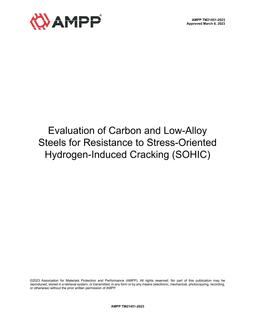
NACE SP0508-2008
Click here to purchase
1.1.1 The assessment and determination of surfacecontamination (by salts) prior to application ofprotective coatings is critical to their service lifeexpectancy. Determination of the level of surfacecleanliness is conducted by extraction of soluble saltcontaminants following ISO 8502-62–The Breslemethod, part of ISO 8502-9. The determination of thelevel of salt is performed by following ISO 8502-9–Field method for the conductometric determination ofwater-soluble salts. The field execution of thisrequirement involves using a syringe to inject deionizedwater into the Bresle patch, washing thesubstrate surface inside the patch, then extracting thetest water for direct measurement of conductivity.Details of this procedure are provided in Appendix A(mandatory). Once a conductive value is determined bythe conductivity meter, expressed as micro Siemensper centimeter. ISO 8502-9 provides aprocedure to calculate the equivalent weight of thesurface concentration as total surface density of thesalts.
1.1.2 Step-by-step execution of the ISO 8502-6 and8502-9 test requirements introduces a number ofpotential variances during the field evaluation. Someexamples include the sensitivity and resolution of theconductivity meter, cycle time of the test water insidethe Bresle patch, human errors in measuring andinjecting the test water, and general operatorexperience. It is known that the accumulation of theseindividual process variances can add up to create anoverall variance in the ISO protocol.
1.1.3 The range of variance in ISO 8502-6 and 8502-9has been demonstrated by extensive laboratory testsconducted by a member of this task group.3 Theprecision of a single ISO 8502-9 test result wasdetermined to be ±8.2 mg/m2 in the range 30 to 80mg/m2. The absolute variance, and not the relative orpercent variance, was found to be constant in thisrange. See Appendix B (nonmandatory) for detailsabout these tests and the data analysis. The testmethod defined in ISO 8502-9 allows certain executionparameters of the test (e.g., size of adhesive patch,volume of test solution, and time of dissolution of saltsinside the adhesive patch: the dwell time) to vary. Thisstandard adopted best practices and has set theparameters in Appendix A. With a dwell time at aminimum of 90 seconds, the variance from operatorerror was found reduced dramatically in case theoperator timing is not perfect. Hence, a dwell time of 90seconds was adopted in Appendix A. For the purposeof defining equivalence, the procedure in Appendix Ashall be used to create the reference values to whichthe candidate method will be validated. See AppendixB for the test rationale.
1.1.4 Any equivalent tools, methods, or proceduresthen must show that they meet the same criteria,thereby providing the same weight measures, and bewithin the same range of variance as would beproduced by following the procedure in ISO 8502-9.
1.1.5 The objective of this standard is to determinewhether methods other than the Bresle patchapplication method are suitable alternatives formeasuring salt contamination in the field. Althoughtests may be performed on flat, horizontal surfaces forease of use, each method should also be capable ofgathering measurements on vertical and overheadsurfaces. When such measurements cannot be madeon vertical or overhead surfaces, this limitation must benoted in the validation report (Section 3).
Product Details
- Published:
- 11/07/2008
- ISBN(s):
- 1575902222
- Number of Pages:
- 11
- File Size:
- 1 file , 180 KB
- Note:
- This product is unavailable in Ukraine, Russia, Belarus
